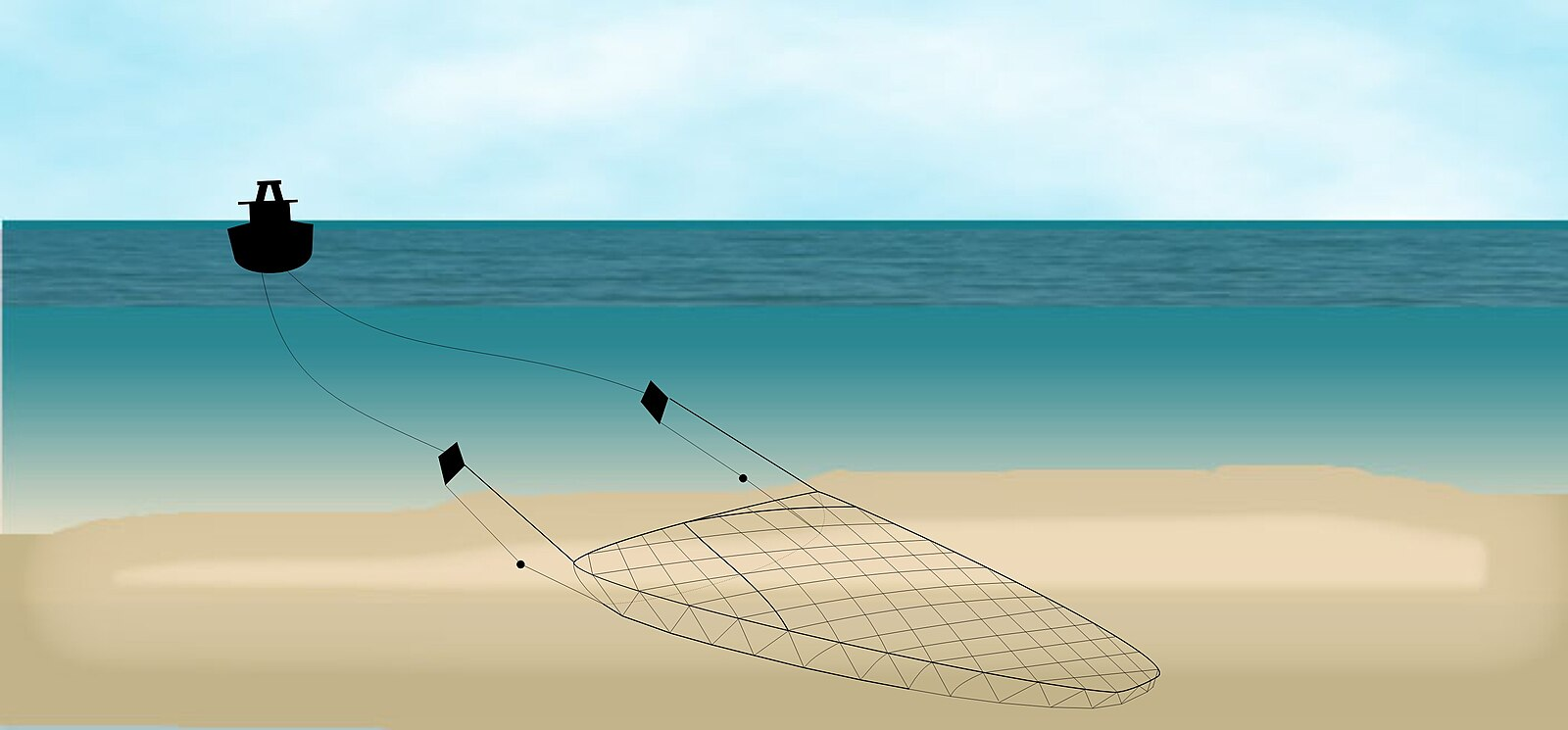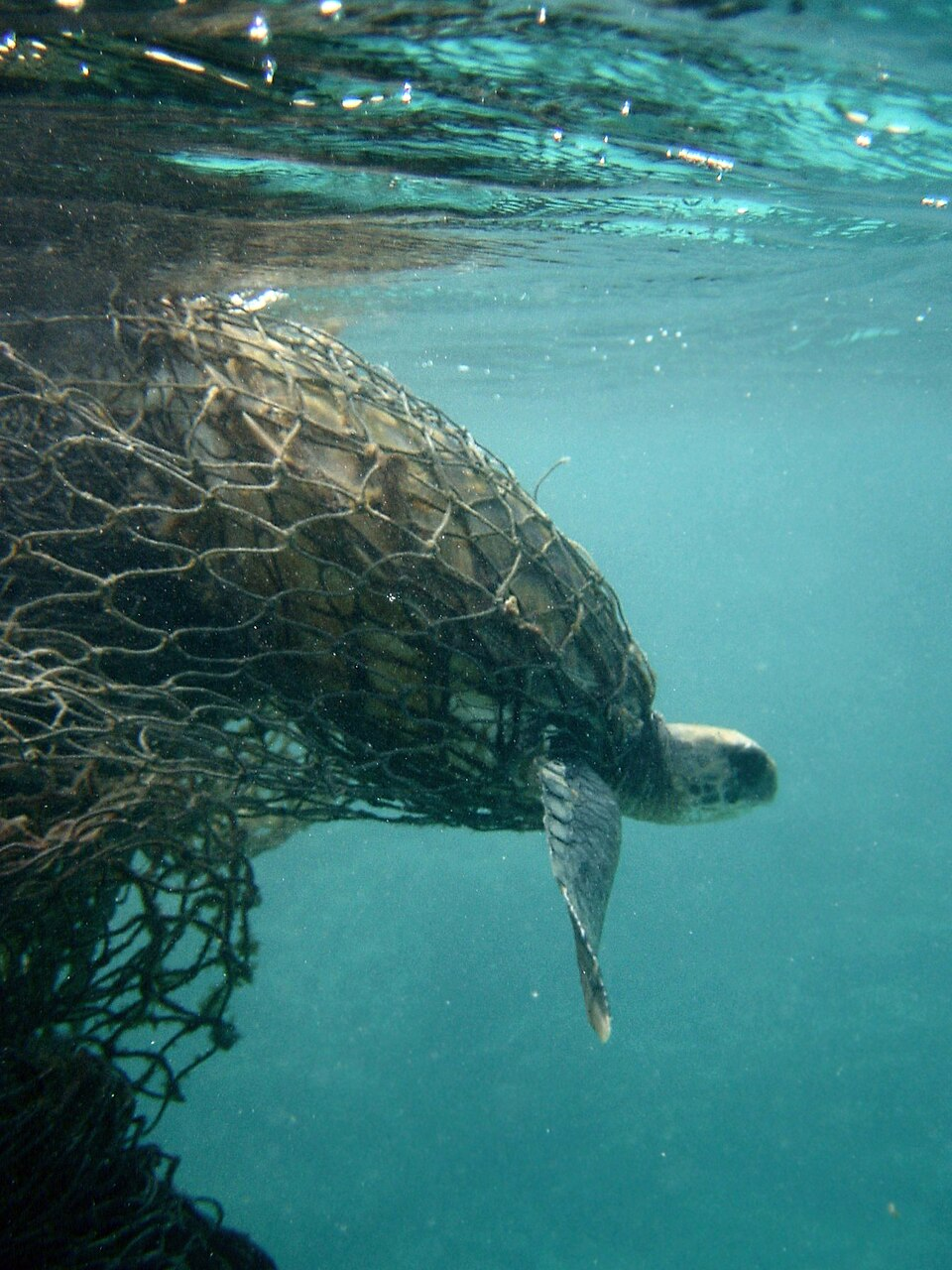IB Syllabus focus:
‘Bottom trawling, ghost fishing, poisons and explosives damage habitats and stocks, driving overexploitation.’
Unsustainable harvesting practices threaten aquatic ecosystems by damaging habitats, reducing biodiversity, and accelerating resource depletion, undermining the long-term sustainability of marine and freshwater food systems.
Understanding Unsustainable Harvesting
Unsustainable harvesting occurs when aquatic organisms are removed at rates exceeding natural replacement or when the methods used directly degrade the surrounding ecosystem. This not only diminishes fish stocks but also undermines the ecological integrity of water systems upon which human societies depend.
Unsustainable harvesting: The exploitation of aquatic resources in ways that compromise the long-term viability of species and the health of ecosystems.
Bottom Trawling
Bottom trawling involves dragging heavy nets along the seabed to capture fish and other organisms.

Labeled diagram of otter trawling, showing doors/boards holding the net open and ground gear contacting the seabed—mechanics that drive habitat disturbance and bycatch. Labels are in Dutch; terminology slightly exceeds syllabus detail but the gear layout is clear. Source.
It removes both target and non-target species, creating large amounts of bycatch.
The process destroys benthic habitats, such as coral reefs and seagrass beds, which act as nurseries for young fish.
Recovery of these habitats can take decades, and in some deep-sea systems, may be effectively irreversible.
Bycatch: The capture of non-target species, including fish, marine mammals, turtles, and seabirds, during commercial fishing operations.
Ghost Fishing
Ghost fishing refers to the continued capture of organisms by lost or abandoned fishing gear.
Discarded nets, pots, and lines remain in the water, trapping fish and invertebrates long after active use.
These organisms often die, contributing no benefit to human consumption but reducing population numbers.
Ghost gear also entangles larger species such as seals, dolphins, and turtles, causing injury and mortality.

Photograph of a green sea turtle entangled in a lost net, illustrating how abandoned gear continues to capture and kill wildlife (ghost fishing). The image focuses on the entanglement mechanics without extraneous detail. Source.
Poisons in Harvesting
Some fisheries employ toxic substances to stun or kill aquatic organisms for easy collection.
Cyanide fishing is particularly destructive in coral reef regions, where cyanide is sprayed to capture live reef fish for aquariums or food markets.
The poison damages corals by killing symbiotic algae and weakening reef resilience.
Chemicals often spread beyond targeted areas, harming non-target species and reducing local biodiversity.
Cyanide fishing: A practice where sodium cyanide is used to stun fish, making them easier to capture but damaging surrounding reef ecosystems.
Explosives in Harvesting
The use of dynamite or explosives to harvest fish remains one of the most destructive practices.
Explosions kill fish instantly, allowing easy collection of floating carcasses.
The blast shatters coral skeletons, reducing complex reef habitats to rubble.
Reefs damaged by explosives may take centuries to recover, if at all.
Ecological Consequences
Unsustainable harvesting practices disrupt ecosystem structure and function.
Reduction of key species alters food web dynamics.
Loss of biodiversity reduces ecosystem resilience to other stressors such as climate change and pollution.
Habitat destruction eliminates breeding grounds, making population recovery difficult.
Ecosystem resilience: The capacity of an ecosystem to absorb disturbances while maintaining structure and function.
Socioeconomic Impacts
Beyond ecological damage, unsustainable practices directly impact human societies:
Collapse of local fisheries undermines food security.
Reduced fish stocks jeopardise livelihoods dependent on artisanal and industrial fishing.
Coastal communities suffer long-term economic loss as resources become depleted.
Drivers of Unsustainable Practices
Several factors contribute to the persistence of damaging methods:
High market demand for fish and seafood, particularly in global export industries.
Weak governance and enforcement, allowing illegal practices to continue.
Poverty and lack of alternatives, which may push communities toward destructive short-term practices.
Technological advances, enabling increasingly efficient but ecologically harmful harvesting.
Towards Sustainable Practices
Although this subsubtopic focuses on destructive methods, recognising alternatives is essential for context:
Selective gear technologies reduce bycatch.
Community-based management can regulate practices.
International agreements aim to restrict the use of poisons and explosives in fisheries.
These measures highlight the pressing need to move away from destructive approaches to secure the long-term sustainability of aquatic ecosystems and the human societies that depend on them.
FAQ
Deep-sea ecosystems recover much more slowly because species grow and reproduce at very low rates. Coral and sponge communities can take centuries to form, meaning damage caused by trawling may be effectively permanent. In shallow areas, some habitats have faster recovery, but deep-water trawling often leads to irreversible biodiversity loss.
Lost or abandoned nets, lines, and traps are mostly made from synthetic plastics. These materials persist for decades in the ocean, breaking down only into microplastics. This contributes not only to entanglement but also to the long-term build-up of plastic particles in food webs and water systems.
Cyanide is used to stun colourful reef fish, making them easier to capture alive. Many of these fish are destined for the international aquarium market. However, cyanide exposure often kills a large proportion of captured fish within days, making the trade wasteful and highly damaging to both reef health and fish populations.
Explosions destroy reef structures instantly, leaving only rubble with little ecological complexity. Storms, while damaging, are less uniform and often leave portions of the reef intact. Explosives reduce habitat availability in a way that prevents recolonisation, disrupting entire ecosystems far more severely than natural disturbances.
Limited access to alternative livelihoods pushes people to maximise short-term catch.
Weak enforcement or corruption allows illegal fishing to continue.
Global market demand, especially for aquarium species or cheap seafood, incentivises harmful practices.
Poverty and lack of education reduce awareness of long-term ecological and economic consequences.
Practice Questions
Question 1 (2 marks)
Define the term bycatch and explain why it is considered a negative consequence of bottom trawling.
Mark scheme:
Definition of bycatch: capture of non-target species such as fish, marine mammals, turtles, or seabirds during fishing operations. (1 mark)
Explanation: leads to waste of resources, death of non-target species, and ecological disruption. (1 mark)
Question 2 (5 marks)
Discuss two unsustainable harvesting practices, describing how each practice damages aquatic ecosystems and reduces long-term fishery sustainability.
Mark scheme:
Identification of two practices: e.g. bottom trawling, ghost fishing, cyanide fishing, dynamite fishing. (1 mark each, maximum 2 marks)
Explanation of ecological damage caused by each:
Bottom trawling destroys seabed habitats, increases bycatch, reduces biodiversity. (1 mark)
Ghost fishing traps organisms long after gear is abandoned, reduces populations, entangles larger animals. (1 mark)
Cyanide fishing poisons coral reefs and kills non-target organisms. (1 mark)
Dynamite fishing destroys coral reef structures and eliminates breeding grounds. (1 mark)
Link to reduced long-term sustainability of fisheries for at least one practice. (1 mark)
Maximum: 5 marks.

